
adls.org.nz NEWS Nov 18, 2022 Issue 41 Inside ■ OBITUARY Sir Ian Barker KC P06-07 ■ GREENWASHING UN calls out a ‘toxic cover-up’ P10-11 Fishhooks facing the digitisation of OUR COURTS
LawNews is an official publication of Auckland District Law Society Inc. (ADLS).
Editor: Jenni McManus Publisher: ADLS
Editorial and contributor enquiries to: Jenni McManus 021 971 598
Jenni.Mcmanus@adls.org.nz
Reweti Kohere 022 882 2499
Reweti.Kohere@adls.org.nz
Advertising enquiries to: Darrell Denney 021 936 858 Darrell.Denney@adls.org.nz
All mail to: ADLS, Level 4, Chancery Chambers, 2 Chancery Street, Auckland 1010

PO Box 58, Shortland Street DX CP24001, Auckland 1140, adls.org.nz
LawNews is published weekly (with the exception of a small period over the Christmas holiday break) and is available free of charge to members of ADLS, and available by subscription to non-members for $140 (plus GST) per year. To subscribe, please email reception@adls.org.nz.
©COPYRIGHT and DISCLAIMER Material from this publication must not be reproduced in whole or part without permission. The views and opinions expressed in this publication are those of the authors and, unless stated, may not reflect the opinions or views of ADLS or its members. Responsibility for such views and for the correctness of the information within their articles lies with the authors.
Cover: seksan Mongkhonkhamsao / Getty Images
02 Contents
Why digitising the courts is a high-risk game HACKERS COST CONTROL 03-05 The complexities of defining and transferring Māori land FREEHOLD GUARDIANS PROTECTION 08-09 Parole Board backs down on curfews JURISDICTION RESTRICTIONS IMPRISONMENT 13 EVENTS 18-19
Write for LawNews LawNews welcomes commentary and opinion pieces from ADLS members and readers. We ask that contributions are civil in tone, factually correct, well-written and logically argued – and fewer than 800 words. And we won’t publish anonymous commentary. Any questions, please email the editor at: Jenni.McManus@adls.org.nz Photo: JulPo / Getty Images FEATURED CPD 14-15 CPD IN BRIEF 16
Digitising the courts: tech-savvy lawyers and others weigh in on the fishhooks
Based on the judiciary’s longer-terms aspirations, by the early 2030s it could be using automated processes to interpret and translate speech, artificial intelligence tools to help identify, organise and analyse relevant information among large bundles of documents, and algorithms to help determine straightforward procedural applications
Reweti Kohere
As the government throws hundreds of millions of dollars at the first phase of a decade-long effort to digitise New Zealand’s courts and tribunals, tech-savvy practitioners are warning of potential fishhooks that could jeopardise its chances of success.
The snags include security risks, the loss of control of the system and threats to harm the judiciary’s integrity, missed opportunities to reform the way court staff work and the possibility of the rule of law becoming “the rule of artificial intelligence”.
While those LawNews spoke to agree that digitisation is sorely needed, there are also fears the current tender process is jumping the gun, by-passing necessary, clarifying discussions among stakeholders.
Nearly $200 million has been earmarked to fund Te Au Reka, a new case management system designed to reduce unnecessary delays and improve access to information through digitising the judiciary’s largely paper-based workflow. The funding comprises $39 million in operating spend and $133 million in capital expenditure, which reflect the “impact on spending” allowances contained in the government’s 2022 Budget rather than the initiative’s overall expected costs.
Previously kept under wraps, the figures have now been released through the government’s electronic tenders service, ensuring all vendors interested in the current Te Au Reka tender have access to the same information, says Ministry of Justice deputy secretary Victoria McLaughlin.
“Therefore, these specific figures are no longer commercially
sensitive. But it should be noted that they do not represent the expected costs of Te Au Reka. The expected costs remain commercially sensitive.”
Even if the government had put aside more funding, the plethora of technology means digitisation can be done at a reasonable cost, says Lloyd Gallagher, managing partner of legal consulting and dispute resolution firm Gallagher & Co.
But his concerns run much deeper than that: “Where the technology is going to be located, how the information is going to be maintained, whether there’s a potential for intrusion, simplicity and the use of it, the difficulties for people who don’t have access to computer systems, how would they still engage in it. These are really where the additional tensions arise.”
Slippery slope
Gallagher, the convenor of ADLS’ technology and law committee, warns that building a domestic case management system comes with pitfalls, including the possibility of intrusion and interception by government and non-government actors, questions about data ownership and control when dealing with foreign third-party vendors, and “bad code”. In his view, oversight should rest with the courts and the government.

Much of the world in early 2020 turned to videoconferencing platforms, such as Zoom and Microsoft Teams, to stay connected and continue working from their homes in the wake of covid-19 lockdowns.
But almost immediately, unidentified individuals started hijacking meetings. In March 2020, the FBI received multiple reports of high school videoconferences being disrupted by pornographic and/or hate images and threatening language. At around the same time, Zoom faced scrutiny for not enabling endto-end encryption (E2EE), generally considered the most private form of internet communication, despite marketing a different kind of encryption it offered as E2EE. By October 2020, Zoom properly delivered on its security promises.
Gallagher recounts a recent experience where he and a private group of users of Teams were inadvertently grouped into a pornography website. As recent as May 2022, participants in an annual computer hacking competition succeeded in hacking Microsoft’s Windows 11 operating system and Teams.
03 Nov 18, 2022 Issue 41 Continued
on page 04
THE COURTS/TECHNOLOGY
Costs and efficiency are often costefficiency for the system itself, not for those using the system
Lloyd Gallagher
The ramifications for the judiciary would be dire if it were caught up in a similar incident, he warns. “If we’ve got the judiciary being pulled into that sort of thing, are we creating a sort of environment where we’re going to get accusations against judges, biased accusations, inappropriate accusations? There’s a slippery slope that could go down.”
Integrity of the courts
Compounding his concerns are the various kinds of sensitive disputes that courts and tribunals must adjudicate – the political, the commercial, the legally privileged, and even matters of national security – and their potential to be made public as a result of intrusion.
Other kinds of court processes, such as testimonies or the sanctity of non-publication and suppression orders, could be threatened if Zoom and other home-based, proprietary solutions are used. With such products, Gallagher explains, there’s no way of being notified of or preventing participants in videoconferencing hearings from recording or screen-capturing the proceedings so any anonymity the courts have ordered could be undermined.
By contrast, AVL products that the courts control could make it easier and quicker for judges to respond to unauthorised recordings.
How can the digital system protect those conversations, and uphold the integrity of court processes? Gallagher asks. “The government needs to consider that putting things in third parties’ hands, like Microsoft and Zoom and that sort of thing, is not necessarily the appropriate way to go.”

Tinker, tailor
LawFest organiser Andrew King applauds the judiciary’s reasons for wanting to modernise the administration of justice: court processes must be capable of delivering just outcomes for all New Zealanders. Digitisation should’ve happened a decade ago, he says, but the fact it’s happening is worth supporting. However, King’s concerns zero in on how the new digital system will be rolled out.
During the 10 years that King has run LawFest, an annual conference on legal innovation and technology, the Ministry of Justice has not attended once, he says. That throws up a raft of follow-up questions: if the judiciary and the ministry want to quickly follow earlier adopters, whom are they following? Do they have the necessary expertise at their disposal?
On launching the strategy document for consultation in September, a media statement from Chief Justice Dame Helen Winkelmann stated Justice David Goddard, tasked with leading the digitisation process, had interviewed heads of bench, Ministry of Justice officials, external stakeholders, and technology experts. Those insights, along with local and international research, had informed the preparation of the strategy.
According to the strategy document, the judiciary aims to be

“fast followers” of solutions that have worked in other similar jurisdictions. Off-the-shelf products, which can be adapted and reconfigured post-purchase to meet orgnisations’ needs, will be preferred over the development of a system bespoke to New Zealand’s courts and tribunals.
King agrees a bespoke system is “the last thing you want” as costs could blow out. But he says the judiciary might have to tailor any off-the-shelf system it is considering. “By having those criteria, it’s pretty much saying ‘we’ll have something that does these things and then we build on these other things’. Well, that’s not an off-the-shelf product,” he says. “That’s building something and tinkering with it. It’s just contrary to that off-the-shelf, fastfollowers comment.”
Wish lists and buzzwords
The judiciary wants a flexible digital system, one that “take[s] advantage of new opportunities for innovation and enhanced delivery of justice”. King says taking advantage of new opportunities sounds like a “buzzword”. “You’ve got to go out there and practically look for what the opportunities for innovation are…You don’t go into The Warehouse and buy this off the shelf. This is quite a complex thing they’re looking to achieve.”
King worries the preferred capabilities appear more like a “wish list”, a problem he observes a lot with tender processes.
“You have a wish list without actually understanding what’s out there, what’s available and how other people are working,” he says. “Anyone can put together a wish list but you need to be educated and informed about what’s happening and what’s doable and what’s a pipe dream.”
Gallagher shares the same sentiment and believes a white paper would have been beneficial for all stakeholders. “We’ve seen it before where stuff has gone out for tender, companies have come in and tendered for it, they’ve got the contract because they’ve got the best price, and then all of a sudden, ‘hello, we hadn’t even considered all these other issues’,” he says. “To my mind, maybe we’re jumping a little bit quick to the tender process before we’ve got all the information that we should be considering.”
‘Rule of artificial intelligence’
The strategy document explicitly recognises the administration of justice is “first and foremost a human process”, although “appropriate use” of digital technology can support and enhance that endeavour.
Based on the judiciary’s longer-terms aspirations, by the early 2030s it could be using automated processes to interpret and translate speech, artificial intelligence tools to help identify, organise and analyse relevant information among large bundles of documents, and algorithms to help determine straightforward procedural applications.
Digitisation is ultimately just a word though, reminds law professor Mark Henaghan. “It’s only as good as the people
04 Continued on page 05 Continued from page 03
Andrew King
The ‘overpositive’ strategy document read more like a sales pitch, than any indepth piece of analysis
Justice David Goddard
feeding the information in. There’s still got to be a human factor,” he says. “We have to hold onto that dearly because it seems to be the rule of law would become the rule of artificial intelligence, which would be very frightening.”
Going digital has its advantages – the ability to better service New Zealand’s multi-cultural population with documents written in multiple languages, for instance, which can be updated more quickly. And more opportunities to see how justice is done, with livestreams of hearings extended beyond the Supreme Court to “appropriate” hearings in other courts and tribunals.
But Henaghan warns that going digital won’t be a “panacea” for quick, efficient and cost-effective benefits. And those benefits mustn’t lose sight of their true recipients.
“Costs and efficiency are often cost-efficiency for the system itself, not for those using the system,” he says. The “over-positive” strategy document reads more like a sales pitch, than any indepth piece of analysis. “We know [with] justice, you have to look at many sides, there’s no simple answer to these things, that it comes with disadvantages. As long as we’re aware of them, we can still go ahead. But at least we know where the pitfalls are,” he says. “But this didn’t seem to indicate any of that at all, which I found quite surprising.”
Judge-time
Justice Goddard told LawNews that one of the project’s major risks is continued under-investment. However, after a couple of decades of insufficient funding, the government has shown a strong commitment to rectify the position. “The most widelyused technology in the courts – the case management system –is 20 years old and is no longer supported by the original vendor,” the judge said. “It’s really clunky. We need to do something that is
NEW TITLE
fit-for-purpose, that is properly built and continues to be properly supported.”
Another risk was managing a process that didn’t focus enough on the end-users, meaning “it doesn’t work as well as it ought to in practice”, the judge said. “In some countries I visited, the design has been very much led by technology people and when it’s landed in the courts it hasn’t worked very well for parties, for the lawyers or for the judges.” For the first time, the judiciary has developed its own digital strategy and how it should be designed. A lot of judge-time is being invested in ensuring the blueprint and model match up with the judiciary’s understanding of the court system and its trajectory.
Conservatism versus revolution
The judiciary’s inherent conservatism is one of its strengths, Henaghan says, enabling it to adopt innovations from the mistakes and lessons of earlier users and to remain self-critical of its processes.
“There are some processes to be improved and sometimes the improvement makes it worse and sometimes it makes things better,” he says.
“You have to keep moving in a way that you think you’re improving things. But you have to keep also realising that, not every new improvement will improve things.”
In digitising largely paper-based systems, though, is the judiciary missing a trick? asks King.
Going digital may introduce efficiencies, he says, “but are we not looking at the bigger picture here? Do we need to perhaps change the way people work? Are there not more efficient ways to do things? Are we just doing certain parts of the task because we’ve always done it?”
The ministry’s Te Au Reka tender closes midday on December 2 and long-listed vendors will be notified before Christmas. ■
The English Text of the Treaty of Waitangi
Author Ned Fletcher
A masterful exegesis … the quality of Dr Fletcher’s research and the power of his reasoning demands attention and respect. There will be those who differ; as I have said, contestation is the Treaty’s only consistent companion. But Dr Fletcher has shifted the debate’s centre of gravity and for that, Treaty law, history and scholarship owe him a debt of gratitude.
Justice Sir Joe Williams (from the foreword)
How was the English text of the Treaty of Waitangi understood by the British in 1840? That is the question addressed by historian and lawyer Ned Fletcher in this extensive work.

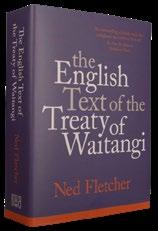
The English Text of the Treaty of Waitangi enriches our understanding of the original purpose and vision of Te Tiriti o Waitangi / The Treaty of Waitangi and its foundational role in Aotearoa New Zealand.
Price $60.86 plus GST*
Price for ADLS members: $54.77 plus GST*
To purchase this book, please visit https://adls.org.nz or contact the ADLS bookstore by phone: 09 306 5740, fax: 09 306 5741 or email: thestore@adls.org.nz
* + Postage and packaging
05 Nov 18, 2022 Issue 41 Continued from page 04
Anyone can put together a wish list but you need to be educated and informed about what’s happening and what’s doable and what’s a pipe dream
Mark Henaghan
Legal profession pays tribute to

Sir Ian Barker KC, 1934-2022
Jenni McManus
Led by Chief Justice Dame Helen Winkelmann, tributes are flowing in for former High Court judge Sir Ian Barker KC who died last Friday at the age of 88.
“Sir Ian was an outstanding judge and a true leader,” the chief justice said. “His distinguished career in the law spanned 60 years of service to the law, to the judiciary – both here and in the Pacific – and to our society. His passing is a loss that will be widely felt.
“On behalf of the New Zealand judiciary, I acknowledge Sir Ian’s service and extend my deepest sympathy to his family.”
Similarly, Maria Dew KC, President of the New Zealand Bar Association, described Sir Ian as a wonderful mentor to herself and others. “We are all feeling saddened by Sir Ian’s loss, and he will be deeply missed,” she said.
“He contributed to many organisations over the years, the NZBA included. At Bankside Chambers, he was kaumatua to all. He rarely spoke about his own accomplishments and instead focused his interests on others and the world outside the law – travelling, writing and engaging to the end. His warm smile will be missed.”
In an interview with LawNews two years ago, Sir Ian spoke of his early days in the law and his first job, with TJ (Tommy) Doole, whose “ghastly” City Chambers were located at the corner of Auckland’s Queen and Wellesley Streets, on the site of the old Auckland jail. Sir Ian said he hated the building. In 1949, then Prime Minister Sid Holland (“one of the least distinguished prime ministers we’ve ever had”) had reintroduced capital punishment and the jail had been the site of hangings.
Sir Ian went to university in 1952, enrolling for a BA. But he didn’t want to teach and didn’t think he was equipped for medical school so eventually decided to sign up for law as well.
Lawyering back then was dominated by conveyancing and the profession was far more collegial “and not as cut-throat” as it is today. Everything was done manually, and law clerks met each other at the Land Transfer Office and at court registries when filing documents. He learnt conveyancing “almost by osmosis”, Sir Ian said. “If you thought
you could do it, they probably let you and that’s the way I met lots of people in the profession.”
There were no large law firms in the fifties and sixties. Most had fewer than eight partners. It was easy for clerks and lawyers to find a job and while the pay “wasn’t great”, there was a reasonable anticipation of partnership within a few years. Sir Ian’s starting pay was £4 a week.
At the time, he said, the Auckland legal profession was dominated by “elderly, idiosyncratic sole practitioners living in rent-controlled buildings” who had kept the profession going after WW2.
There was little specialisation. Most lawyers were conveyancers or, in pre-ACC days, did personal injury claims. “There were no sports lawyers or RMA lawyers or immigration lawyers and there certainly weren’t environmental lawyers.”
However, conveyancers had to deal with a piece of legislation – the Town and Country Planning Act 1953 – that almost rivalled the Resource Management Act in terms of its complexity and opacity, Sir Ian said.
He graduated with a BA/LLB and was admitted in 1958. Of the 23 students finishing university that year, only one was a woman. From Tommy Doole’s chambers, where he’d acquired a lot of experience in the Magistrates’ Court, Sir Ian moved to Morpeth Gould (now Morrison Kent) where one of his first cases – and his first criminal matter – involved three men charged with being “rogues and vagabonds” in a case that eventually made its way into the law reports.
The following year, Sir Ian did his first murder trial where he was junior to Martyn Finlay, who later became President of the Labour Party and Attorney-General and Minister of Justice in the governments of Norman Kirk and Bill Rowling respectively.
His big break came in 1966 where he successfully represented businessman Jim Jeffs at the Privy Council in a stoush with the New Zealand Dairy Board. To keep costs down, Sir Ian did a deal with his friend Paul (later Justice) Temm who was appearing before the Privy Council at the same time to argue Frazer v Walker (which became the
06
OBITUARY
Continued on page 07
I guess one of my advantages in the law is that I’ve got a good memory. Whatever success I’ve achieved, it’s partly due to that
Sir Ian Barker KC
leading case around the Torrens system of land registration).
“Over a drink, we agreed to combine forces, with me leading him in Jeffs and him leading me in Frazer v Walker,” Sir Ian wrote later in an article for the New Zealand Law Society. “It happened that their Lordships found this swapping of senior counsel role odd and queried it at the start of the hearing for the second appeal. We were able to advise their Lordships that we had both been admitted as barristers on the same day in February 1958. That explanation seemed to satisfy the judges.”
Jeffs went on to found the ill-fated conglomerate JBL which collapsed in 1972, leaving thousands of out-of-pocket investors and a mess that took receiver Doug Hazard 25 years to clean up. Jeffs and his brother Vaughan were prosecuted; Jim Jeffs was sentenced to nine months’ jail while Vaughan was fined.
“Things were always exciting with the Jeffs,” Sir Ian told LawNews
He left Morpeth Gould for the bar in 1969, became a QC in 1973 and was appointed to the High Court bench in 1976, at the age of 42. He quickly made a name for himself as an astute commercial judge, with a talent for dealing with complex and detailed matters. One such case was the 10-yearlong Securitibank litigation (Re Securitibank Ltd No 2 [1978]). The biggest corporate collapse in New Zealand history at the time, Securitibank went bust in December 1976, owing between $30 million and $50m to investors and other creditors.
Sir Ian, along with Sir John Henry, also founded the fast-track Commercial List in the High Court at Auckland. Spawned by the fallout from the 1987 sharemarket crash, the list was the brainchild of the two judges and then Justice Minister Sir Geoffrey Palmer. It was designed to fast-track the interlocutories – “making them all happen at once”, as Sir Ian put it – at the point where most of the delay in traditional civil litigation takes place.
In 1997, at the age of 62, Sir Ian quit the bench. The mandatory retirement age for judges at the time was 72 but he’d had enough. “There was a new Arbitration Act and it seemed like a good opportunity,” he said.
Mediation was also coming into its own. Sir Ian said he’d been at a judges’ conference in Auckland around 1994 and one of the speakers, a mediator from Australia, was keen to share what was happening across the ditch. “A lot of the judges and lawyers weren’t impressed,” Sir Ian said. “They thought it was a fad.”
He suspected they were wrong. And while he didn’t do many mediations, Sir Ian carved out an impressive international reputation as an arbitrator, retiring from this work only in 2019. Along the way, he was a founder of Bankside Chambers in Auckland in 2001 and was the longest-serving chancellor of the University of Auckland.
After his retirement from the New Zealand bench in 1997, Sir Ian sat on several Pacific courts, including Courts of Appeal in Fiji, Samoa, Vanuatu, Pitcairn and Kiribati.
One of his most high-profile cases was in 2001 when he sat on the court that decided the legitimacy of George Speight’s coup in Fiji. It was “pretty tense”, Sir Ian said. “We all stayed in the Travelodge and had to be driven across the road to the court. There were armed guards on the roof of the hotel and sleeping on the same floor as the judges.”
Asked about the secret to his success, Sir Ian said: “I guess one of my advantages in the law is that I’ve got a good memory. Whatever success I’ve achieved, it’s partly due to that.” ■
DEPUTY LEGAL COMPLAINTS REVIEW OFFICER
Expressions of interest are invited from suitably qualified persons for the position of a full-time Deputy Legal Complaints Review Officer (LCRO). Under the Lawyers and Conveyancers Act 2006, appointment to this position is made by the Minister of Justice, in consultation with the New Zealand Law Society and the New Zealand Society of Conveyancers.
As a Deputy LCRO you will provide independent oversight and review of the decisions of the Standards Committees of the NZ Law Society and the NZ Society of Conveyancers, which handle complaints in the first instance.
To be appointed a Deputy LCRO you must not be practising as a lawyer or conveyancer at the time of appointment. Applicants will, however, be required to have a comprehensive knowledge and understanding of the New Zealand legal environment, and a familiarity with the professional conduct issues that arise in day-to-day legal practice.
The preference is for the appointee to be based in Auckland but location elsewhere may be considered.
Additional information and application forms can be found on the Ministry of Justice website here
Applications close at 4.30 pm Friday 18 November 2022.
Please email your completed application forms, curriculum vitae and a covering letter to General.OLC@justice.govt.nz
or post to:
Appointments and Specialist Functions Unit Ministry of Justice SX10088 WELLINGTON

07 Nov 18, 2022 Issue 41
Continued from page 06
The complexities of defining and transferring Māori land
Sacha Jugum
Māori Affairs Act 1953 (now repealed) – appeal from Māori Appellate Court over finding that land was Māori freehold land –applicable principles – procedure – statutory interpretation and analysis – statutory definitions and types of land – legislative history – analysis of historic memorandum of transfer – analysis of sequence of land transfers and purchases – process of alienation of Māori land – whether any defect in transfer is subsequently cured – public policy – “protective stance” and “guardian” status of Māori Land Court – precedent – appeal dismissed
Phillip
Please note:
■ some phraseology is quoted directly from the now repealed Māori Affairs Act 1953. This is noted and shown in quotation marks for completeness; and
■ this detailed decision may interest conveyancing practitioners and all those interested in legislative history and Māori land law.
Background
In 1976, the Māori Land Court made an order that a certain area of land was owned by two people (Ms L and Mr D, who are unconnected with these proceedings). That land was not registered under the Land Transfer Act 1952.
In 1980, Ms L agreed to sell her share of the land to another unconnected party, Mr W. The Māori Land Court confirmed that agreement, noting that Mr D was deceased and attempts had been made to contact his widow.
Therefore, only Ms L’s share was transferred to Mr W under the auspices of the Māori Land Court and pursuant to the statutory regime of the Māori Affairs Act 1953 which was in force at the relevant time but has now been repealed.
Later, in 1980, the District Land Registrar entered the land into the provisional register and subsequently registered the memorandum of
transfer from Ms L to Mr W.
The District Land Registrar also created a certificate of title for the land, recording Mr W as the sole owner. Mr D’s share was mistakenly omitted from the certificate of title.
Mr W subsequently transferred the land to a third party and subsequent transfers/sales over the intervening years saw the land in question now owned by the applicants in this present proceeding. TT subsequently attempted to sell the land and obtained a pre-validation report from LINZ. That report identified the land as potentially being Māori freehold land, with this status deriving from the circumstances outlined above and specifically the 1980 memorandum of transfer.
TT then applied to the Māori Land Court and that court determined that the land was Māori freehold land. TT’s appeal to the Māori Appellate Court on this determination was unsuccessful and TT then appealed to the Court of Appeal.
Counsel were appointed to assist the Court of Appeal, as due to the nature of the appeal there were no opposing counsel.
TT’s appeal to the Court of Appeal
The Act recognised three main types of land, being customary land, general land and Māori freehold land.
The appeal concerned the difference between general land and Māori freehold land. The background facts of the sequence of transfers were not in dispute, however TT’s appeal focused on the interpretation of certain provisions of the Act and the way in which that statute had been applied to the 1980 memorandum of transfer. TT focused on s 2(2)(f) of the Act which in broad terms stated that where in certain circumstances there had been a transfer of the legal fee simple, Māori land could be deemed to be general land, “except where it appears on the face of the instrument of transfer that the land has remained Māori freehold land”.
TT therefore argued as part of its appeal that there was nothing on the face of the 1980 memorandum of transfer that indicated the land was Māori land. So, the statutory exception in s 2(2)(f) of the Act was not engaged and the land should be deemed general land.
08 Continued
page 09
on
Peacocke, Susan Peacocke and CR Rejthar Trustees Limited as Trustees of the Totoro Trust [2022] NZCA 469 (Brown, Clifford and Gilbert JJ)
CASE NOTE
The appeal concerned the difference between general land and Māori freehold land
The Court of Appeal: analysis

Applicable principles – procedure – statutory definitions –the statutory phrase in the Act of “alienation of land by Māoris” [sic] and the statutory role of the Māori Land Court to confirm any such transfer – whether TT was entitled to rely on the content of the 1980 memorandum of transfer – whether the land was “deemed to be general land” in the circumstances that had occurred, the information on the “face of the transfer” and pursuant to s 2(2)(f) of the Act – the court noted that the 1980 memorandum of transfer showed Ms L’s particular number of shares that she owned together with the total number of shares of the property made it clear there was at least one other owner – analysis of the statutory phrase “in accordance with its tenor” in relation to the 1980 memorandum of transfer – consideration of the status of the land and analysis of the submissions of counsel appointed to assist the court – detailed discussion of the appropriate legal test to apply in determining the status of the land with extensive discussion of the statutory regime, the legislative history and public policy factors, including the “very protective stance” of the Māori Land Court over Māori land and its status as a “guardian” of that land –
whether “something unequivocal” is required in relation to determining status of land and/or in assessing the applicability of s 2(2)(f) of the Act [this phrase was found to be an unnecessary gloss on the language of the statute] – relevance of the ethnicity of the transferor and transferee under the Māori land framework, and the way that may affect status of land – whether land can have dual status [no] – whether the subsequent transfers of the land were valid under the Act and/or somehow cured the earlier defect – extensive reference to precedent.
The decision
The Court of Appeal held that the 1980 memorandum of transfer transferred only a partial interest in the estate of the land and not the entire legal fee simple estate.
The alienation of Mr D’s share (the individual whose ownership share was mistakenly omitted from the certificate of title) occurred without the consent of the Māori Land Court and so was in contravention of the Act. Section 2(2)(f) of the Act therefore did not apply to either of these transactions and so the land remained Māori freehold land. This status was unaffected by subsequent transfers –TT’s appeal is dismissed. ■
Sacha Jugum is a senior solicitor at Brookfields and editor of The Bulletin ■

ADLS Annual
09 Nov 18, 2022 Issue 41 Continued
from page 08
WHEN
WHERE Rydges Hotel, 59
CBD DRESS CODE Business attire FOR MORE INFORMATION AND TO REGISTER, PLEASE CLICK HERE OR EMAIL EVENTS@ADLS.ORG.NZ
Breakfast with the Attorney-General Hon David Parker
Friday, 2 December 2022, 7:15 8:30AM
Federal Street, Auckland
Toxic cover-up: six lessons to be drawn from the UN’s scathing report on greenwashing
action. For example, one-third of firms on the Forbes Global 2000 list of publicly traded companies have net-zero emissions targets. However, two-thirds of them have not outlined how they will achieve the goal, analysis shows.
Australian oil and gas giant Santos is facing legal action in the Federal Court over its net-zero claims.
In some cases, companies make demonstrably false claims about the steps they’re taking on climate change. In fact, the Australian Securities and Investments Commission (ASIC) says a global investigation has found as many as 40% of environmental claims made by companies may be fraudulent.
ASIC, along with the Financial Markets Authority in New Zealand, has identified greenwashing as a key concern for consumer and market confidence.
The United Nations this week slammed corporate greenwashing and said organisations cannot claim to be net-zero while supporting fossil fuel projects.
The report, released at the global COP27 climate conference in Egypt, called for new rules to ensure emissions pledges were credible and transparent.
UN Secretary-General António Guterres appointed the expert group in March. Releasing its report this week, Guterres had strong words for companies that use “bogus” net-zero pledges to cover up massive fossil fuel expansion: “It is rank deception. This toxic cover-up could push our world over the climate cliff. The sham must end.”
Guterres said loopholes in rules around corporate emissions reporting are “wide enough to drive a diesel truck through” and require major tightening. Let’s look at what that means for corporations.
A global problem
Public concern about climate change is vast and growing. This presents a legitimate economic opportunity for businesses and investors that offer climate-friendly products and services.
But being climate-friendly is not always easy. It may involve significant upfront investment. And measuring, verifying and reporting emissions reduction can be complex.
Concerningly, there’s often a big gap between promises and
The commission is investigating several listed entities, super funds and managed funds over their green credentials claims. Last month, it announced it had fined Tlou Energy more than A$53,000 for making alleged false or misleading sustainabilityrelated statements to the ASX.
Our submission to the UN expert group focused on claims made by fossil fuel companies in Australia and overseas. We explained how natural gas is being promoted as a green investment and a source of emissions reduction in ways that mislead environmental regulators and investors.
Greenwashing doesn’t just have disastrous consequences for the climate. It also harms public trust in all net-zero promises which delays support for real efforts.
As Guterres said this week, we must have zero-tolerance for net-zero greenwashing. He touted the expert UN report as a how-to guide to ensure clarity and accountability for corporate climate pledges.
Things to consider
The report made several recommendations relevant to businesses and financial institutions, as well as state, territory, and local governments.
When such organisations are drawing up a net-zero
10
Keegan Robertson, Hugh Finn & Ifan Odweyn Jones
GREENWASHING Continued on page 11
Successful court action may require a shift away from traditional legal arguments towards more innovative approaches, such as pursuing companies under corporate law
It is rank deception. This toxic cover-up could push our world over the climate cliff. The sham must end
pledge, it must:
■ make a fair effort, commensurate with the companies’ contribution to the problem;
■ be in line with official scenarios limiting warming to 1.50C and should include interim targets every five years starting in 2025;
■ make real emissions cuts rather than relying on carbon offsets, which are often lacking in regulation and rigour;
■ cover all greenhouse gas emissions, including those occurring along a company’s supply chain and through the use of its products;
■ include specific targets to end the use of, and support for, fossil fuels; and
■ include public progress reports with verified, standardised information.
The report’s recommendations are not legally binding. While it shifts expectations of what constitutes misleading and deceptive conduct under Australian law, the late climate law expert Sarah Flynne has observed the difficulty, to date, in prosecuting greenwashing cases.
Flynne argued successful court action may require a shift
away from traditional legal arguments towards more innovative approaches, such as pursuing companies under corporate law. This is the approach being taken in the legal case against Santos mentioned above, which alleges the company breached the Corporations Act and Australian consumer law.
The UN recommendations mean some companies will now be even more heavily scrutinised by investors and the public, such as those relying on carbon offsets to meet their climate pledges.
Companies that commit to net-zero pledges while continuing to build or invest in new fossil fuel projects will also be in the spotlight.
And as the federal government takes steps to meet its own climate commitments, pressure on businesses and governments is also likely to increase.
We are at a crucial moment in history. Humanity must act now if it hopes to stabilise Earth’s climate and leave an inhabitable planet for future generations and corporations must be forced to walk the talk. ■
Keegan Robertson is a PhD student at Curtin University, Hugh Finn is a lecturer at Curtin and Ifan Odwyn Jones is an emeritus professor at Curtin ■
The above was first published by The Conversation and is republished with permission

11 Nov 18, 2022 Issue 41
Continued from page 10
ASIC says a global investigation has found as many as 40% of environmental claims made by companies may be fraudulent
Introducing Reweti Kohere, our new senior journalist at LawNews
Ko Reweti Kohere toku ingoa, he uri ahua ki Ngāti Porou me Muaupoko. Tēnā koutou, tēnā koutou, tēnā koutou katoa.
Kia ora, I’m Reweti Kohere. Through my dad, I trace my whakapapa to Ngāti Porou, and Muaupoko through my mum. I grew up in Whanganui, the eldest of three army kids, and I’m a product of Whanganui High School.
After secondary school, I worked in the UK as a gap year student at Salisbury Cathedral School before returning home to study at Victoria University. In 2016 I graduated with an LLB/BA in Political Science.
Throughout my studies, I worked in the Ministry of Social Development’s historical claims team, doing discovery for cases of historical state abuse. By the time I graduated, I’d decided not to practise law, a career decision that necessitated some soul searching.
I landed on journalism, completing my postgraduate diploma at Massey University in 2018 and topping my class. For someone who didn’t study economics or accounting

at high school, I’d topped the business reporting section of my course. So, sure enough, I started as a junior business reporter at the NBR, covering the energy market, the legal profession and the courts for two years.
In September 2021, just as the government was returning Auckland to alert level four lockdown, I shifted to The Spinoff to cover business and money, plus culture and netball.
Starting a new job virtually, not to mention during a global pandemic, was challenging but I’m grateful for the lessons and growth I was afforded at the publication. A month ago, I returned to the law as a senior journalist at LawNews
It’s good to be surrounded again by the law. My inbox is always open for feedback or story tips, or simply to connect.
Ngā mihi nui, Reweti Reweti.kohere@adls.org.nz
PROPERTY LAW
TEMPORARY COVID-19 MEASURES UNDER THE PROPERTY LAW ACT 2007 ARE
COMING TO AN END
On 16 May 2020, temporary law changes were made to the Property Law Act 2007, extending the timeframes relating to:
■ the default period for unpaid rent and the landlords’ notice period to cancel commercial leases for unpaid rent in ss 245(1)(a) and 245(3)(c) of the PLA from 10 working days to 30 working days; and
■ the timeframes given to mortgagors to remedy any default under s 120 of the PLA from 20 working days to 40 working days.
With the expiry of the Epidemic Preparedness (covid-19) Notice 2020 on
20 October 2022, the temporary law changes come to an end at the close of the six-month period following expiry of the EPN. Accordingly, the extended timeframes under the EPN are expected to revert to the original 10 working days for commercial leases and 20 working days for mortgages under the PLA with effect from 20 April 2023.
For clarity, the expiry of the EPN has no effect on the landlord’s notice period for a tenant to remedy any breach of any other covenant or condition in the lease under s 246 of the PLA (the notice period being a time that is reasonable in the circumstances). ■
12
ADLS PEOPLE
Reweti Kohere
A notice from the ADLS Property Law Committee
Parole Board scraps curfew conditions
Conrad Wright
After reconsidering its ability to impose curfew conditions, the Parole Board has decided to remove them.
Since the Parole Act 2002 came into force, the board has imposed two types of curfews as a condition of granting parole: a simple curfew requiring a parolee to remain at home at certain hours (usually at night) and a “residential restrictions” curfew pursuant to ss 15 and 33-35 of the Parole Act 2002.

More than 800 people are subject to simple curfews. But after the Supreme Court’s judgment in Woods v New Zealand Police [NZSC 141] 220, the board has issued a memorandum stating its view of the impact of Woods
The board notes that the decision means it has no jurisdiction to impose a simple curfew, but it retains jurisdiction to impose the “residential restrictions” type of curfew.
Woods addressed a sentencing court’s power to impose release conditions as part of a short sentence of imprisonment. The conditions imposed on the appellant were to reside at a particular address, remain there between 8pm and 8am, be supervised by a probation officer and submit to electronic monitoring to check location and, the court held, compliance with the curfew.
The court said these conditions equated in substance to residential restrictions, as described in s 33(2) of the Parole Act 2022. However, s 93 of the Sentencing Act 2002 outlines the special release conditions that may be imposed by a sentencing court and states that special conditions include “conditions of the kind described in section 15(3) of the Parole Act 2002, other than a residential restriction condition […].”
The court determined that the sentencing court was not entitled to impose the release conditions it had.
The judgment in Woods is not merely a black letter reading of the relevant legislation, but reinforces a rights-consistent reading of the law. The board’s memorandum notes the Supreme Court’s finding at [68]:
Secondly, reading the text of s 93(2B) as precluding the
imposition of special conditions that have the effect of detaining an offender in their residence for 12 hours a day is the most rights-consistent reading of the provision. If an unrestricted power to order such detention were intended, then it could be expected that Parliament would have spoken directly to confer that power. But there is no express power to detain set out in s 93 of the Sentencing Act or s 15 of the Parole Act, other than the power to impose a residential restriction condition contained in s 15(3)(ab), which is excluded from the types of conditions which a sentencing judge may impose.
Applying this logic, the board concluded it had no ability to order a parolee to adhere to a simple curfew. Its memorandum states, “a curfew that simply requires an offender to be at a particular residence between particular hours by itself is not authorised by the Parole Act given that it is outside the residential restrictions regime”.
The board says it is “working with Corrections, offenders and lawyers to identify all offenders who are subject to a curfew and work as speedily as possible to cancel those curfews”.
Lawyers who are aware of clients or former clients who are on simple curfews may be able to help the board and their (former) clients by bringing this matter to their attention.
The board’s memo says a hearing is required to cancel a special condition but does not require the parolee’s attendance and an application by a parolee to amend conditions will not be necessary. However, others believe there may in fact be a need for a parolee to return to the board to cancel a condition imposed ultra vires
Finally, the board’s memorandum notes two further issues: the need to notify registered victims of amended conditions and that in some cases the board will elect to impose residential restrictions in lieu of a simple curfew. This will require a formal hearing. ■
■
13 Nov 18, 2022 Issue 41
Conrad Wright is a lawyer at the Public Defence Service and a member of the ADLS Parole Committee
CRIMINAL LAW
Applying this logic, the board concluded it has no ability to order a parole to adhere to a simple curfew
Photo: BrianAJackson
/ Getty Images
Advanced parole law

Livestream | In Person
1.5 CPD hours
Monday 21 November
4.30pm – 6pm
Price from $100 +GST
Presenters Emma Priest, barrister, Blackstone Chambers and Hannah Kim, barrister
Parole law is a growth area, as more prisoners are wanting legal representation when seeking parole. Broaden your skills with this practical session on advanced parole law and complex applications.
Chair Sir Ron Young, chairperson NZ Parole Board

Managing IP disputes
Livestream | In Person
1.5 CPD hrs
Tuesday 22 November
4pm – 5.30pm Price from $110 + GST
Presenters Jane Glover, barrister, Sangro Chambers and Kevin Glover, barrister, Shortland Chambers
Decisions made at the outset of an intellectual property dispute can have a strong bearing on how the case is ultimately resolved. This seminar will outline typical scenarios and how you can be an effective first port of call for your prospective plaintiff or defendant client.

Ramifications of Sequana
Livestream | In Person
1.5 CPD Hours
Wednesday 23 November
4pm – 5.30pm
Price from $110 + GST
Presenter John Land, barrister, Bankside Chambers
Chair Sean McAnally, barrister, FortyEight Shortland Barristers
The recent judgment of the UK Supreme Court in BTI 2014 LLC v Sequana and others [2022] UKSC 25 creates a change in directors’ obligations to a company’s creditors and shareholders. Join us to learn how this decision may impact our own Supreme Court’s rulings.
14 FEATURED CPD ALL
COMMERCIAL SEMINAR
LEVELS
ADVANCED PAROLE SEMINAR
ALL LEVELS COMPANY SEMINAR
NOTICE
LIVESTREAM
LIVESTREAM
LIVESTREAM IN
FINAL NOTICE
FINAL
FINAL NOTICE
IN PERSON
IN PERSON
PERSON
PPPR Act proceedings
ALL LEVELS PPPR WORKSHOP
adls.org.nz/cpd cpd@adls.org.nz 09 303 5278

In Person workshop
4 CPD hrs
Tuesday 29 November 8.30am – 1pm
Price from $400 +GST Facilitators Theresa Donnelly, legal services manager, Perpetual Guardian and Alan Gluestein, barrister, Wyndham Chambers
This workshop is designed for experienced and inexperienced lawyers working with the PPPR Act. As a practical session, it will focus on proceedings, capacity assessment issues and the philosophy underlying the legislation

Limited spaces available
Video guest Dr Jane Casey consultant psychiatrist and psychogeriatrician
FIND OUT MORE
Using declaratory judgments
Webinar 1.5 CPD hrs
Thursday 1 December
1pm – 2.30pm
Price from $110 + GST
Presenter Hamish McQueen, senior associate, Gilbert Walker
Valuable insights for litigators on this useful remedy, including why you might seek a declaratory judgment, the legal tests and practical guidance on procedure.
FIND OUT MORE
Livestream | In Person
2 CPD hrs
Tuesday 6 December
Contract law update

ALL LEVELS COMMERCIAL SEMINAR
4pm – 6.15pm
Price from $140 + GST
Presenters Graham Kohler KC, Kate Davenport KC and Yvonne Mortimer-Wang, barrister, Shortland Chambers Chair Paul David KC
An update on what’s happening in New Zealand and elsewhere with contract interpretation, implied terms and damages.
15 Nov 18, 2022 Issue 41
ALL LEVELS CIVIL LITIGATION WEBINAR
LIVESTREAM IN PERSON
Evidence law update

Livestream 2 CPD hrs
Thursday 8 December 4pm – 6.15pm
It’s vital to keep abreast of developments in evidence law and procedure. Presented by evidence law lecturers and two co-authors of the 2018 text Mahoney on Evidence: Act & Analysis, this seminar will focus on the application of key sections of the Evidence Act 2006 in both the civil and criminal law jurisdictions.



Writing right –for family lawyers
Lawyer for child: tips
Livestream | In Person
2 CPD hrs
Thursday 16 February 2023 4pm - 6.15pm
Presenters Judge Kevin Muir and Brian Carter, barrister
Presenters Scott Optican, associate professor, University of Auckland and Jack Oliver-Hood, barrister/lecturer, AUT Law School FIND OUT MORE LIVESTREAM IN PERSON
This seminar, with bench and bar perspectives, aims to provide direction and insights into effective, concise drafting.
Livestream | In Person
2 CPD hrs Tuesday 28 February 2023 4pm - 6.15pm
Presenters David Amodeo, barrister; Val Muller, barrister; Sonya Singh, barrister and Craig Walker, service manager family court coordinators, District Courts, Ministry of Justice
Offering practical perspectives from those in the role, the judiciary and the ministry, this seminar will give key insights into what the role is (and is not), the statutory framework, the balancing act required between the child’s views and his or her welfare and best interests, the role in different contexts and managing challenges; and the use of reports.
Chair Judge Alexander Laurenson
16 CPD IN BRIEF
CPD In person, online, ondemand. Make your CPD work for you. It ' s as easy as 1-2-3! 1. Learning Needs
your learning needs and propose actions.
here to be taken to Step 1 of your CPD Plan & Record. 2. Book Activities
and book CPD activities via the CPD Calendar or the On Demand Library 3. Completed Activities
and reflect on your completed activities and hours earned.
here to be taken to Step 3 of your CPD
Record.
LIVESTREAM IN PERSON
Identify
Click
Browse
View
Click
Plan &
FIND OUT MORE
WILL INQUIRIES
Please refer to deeds clerk. Please check your records and advise ADLS if you hold a will or testamentary disposition for any of the following people. If you do not reply within three weeks it will be assumed you do not hold or have never held such a document
LawNews: The no-hassle way to source missing wills for $80.50 (GST Included)
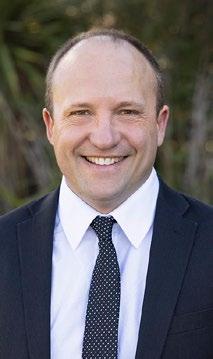
reception@adls.org.nz ADLS, PO Box 58, Shortland Street, DX CP24001, Auckland 1140 Fax: (09) 309 3726 (09) 303 5270
Ben Snedden
Family Law Barrister
Ben has returned to Hobson Chambers after a year in England. During his time away Ben qualified as a solicitor advocate in England and completed the Advanced International Advocacy Course at Keble College, Oxford. Ben is available for instruction on all family law matters including on a fixed fee basis.
Please contact Hobson Chambers on (09) 379 7658 for any bookings.
Offices Available
Following some barristers retiring, we have three offices of varying sizes available for rent.
The Chambers share a refurbished floor (with separate areas) with Hussey & Co., a boutique forensic and general accounting firm. There are shared meeting rooms (a formal boardroom with video conferencing facilities and a less formal meeting room), and communal entrance and client waiting area.
Telephones, internet connection, printing and secretarial services also available and some furniture available.

Cost depends on office size and range from $150 – $300 per week plus gst. No long-term commitment required.
Photographs of the Chambers can be viewed at www.hco.co.nz/gallery.
Contact: Shane Hussey for further details, Shane@hco.co.nz 09 300 5481
Ben Te Rata
• Late of 52 Montilla Place, Manurewa, Auckland
• Married
• Tanker driver
• Aged 59 / Died 29’07’22
• Late of Roselea Care Home, 12 Stanley Street, Hamilton or 8 Miriama Street, Taumarunui
• Single
• Retired
• Aged 88 / Died 18’10’22
SMITH
Tahu Danie
• Late of 1119B Tauranga Road, RD 3, Matamata
• Single
• Beneficiary
• Aged 66 / Died 24’10’22
17 Nov 18, 2022 Issue 41
To view the PD click here We' re looking for a lawyer who is looking for a change. • Passionate about promoting a thriving legal community in New Zealand?
Interested in managing a portfolio of specialist legal committees?
Want to join a team making a real difference to the law and the legal profession? Interested? Are you... Tony Horrocks is available for locum and part-time consultancy work (flexible as to location). Many years’ experience, both as a sole practitioner and as a partner in a small law firm, in general practice, with particular expertise in trusts, estate administration, and business law. Contact me by email: anthonycharleshorrocks@gmail.com or on mobile: 021 754312.
Died 19’09’22
•
•
LAURENSON Joanne Louise • Late of 1 Thornburn Road, Ruatangata, Whangarei • Aged 47 /
PHILLIPS
REDDINGTON Michael Stephen
Events
Book launch: Sale of Land 4th Edition by Don



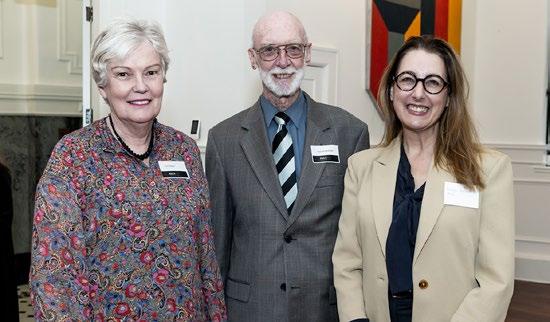
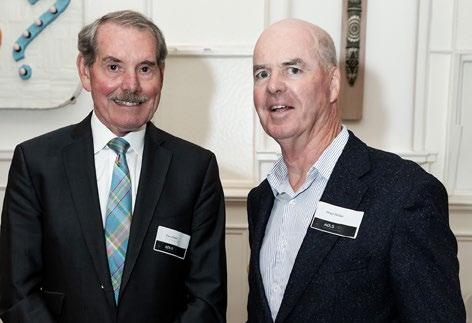
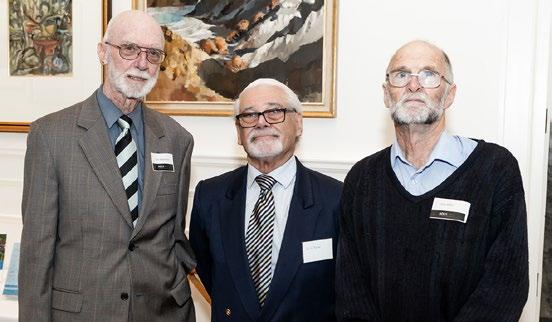
18
Nicole Warner, Ann-Marie Anderson and Anthea Coombes
Jeremy Goodwin and Katerina Wendt
Don McMorland, David Porter and John Millar
Joanne Pidgeon, Stephanie Penn and Reweti Kohere
Sue Keppel, Don McMorland and Monique Pearson
The Administrator House, Tuesday 8 November. For a profile on the author, Don McMorland, please click here
McMorland
Tim Jones and Peter Nolan
Featured
events
Connecting New Zealand lawyers
Annual breakfast with the Attorney-General
Friday 2 December
7.15am – 8.30am
Rydges Auckland, 59 Federal Street, Auckland CBD


East Auckland express lawyers’ lunch
Thursday 8 December
12.30pm – 2pm Grangers, 1 Ara-Tai Road, Half Moon Bay, Auckland
Briefs
Correction and clarification
In a story headed Defence lawyers line up against minister’s plan to revamp name suppression law, published in last week’s LawNews, we incorrectly described a name suppression applicant as a young Labour Party staffer. The 20-year-old man, whose name remains suppressed, was neither a Young Labour member nor staffer when he attended a Labour Party youth camp in 2018. The man was originally charged with five counts of indecent assault. Two of the charges were later dismissed, one was withdrawn and the remaining two were amended to common assault. On the residual charges, the man pleaded guilty and was discharged without conviction.
ESG broken?
A second former executive at BlackRock – the world’s largest asset manager – has publicly debunked the concept of ESG (environment social and governance) investing.

Terrence Keeley, in a new book
Sustainable: Moving beyond ESG to impact investing, says the ESG model is broken, and the strategy is neither a reliable generator of returns nor a real catalyst for change.
Keeley says investors should instead give their money to polluters and force them to clean up their act.
In 2019, BlackRock’s former Chief Investment Officer for sustainability, Tariq Fancy, said the ESG push was leading the world into a “dangerous mirage” and that governments, not investors, should take the lead on climate change.
Crypto collapse
Bahamas-based FTX, the world’s largest crypto exchange, imploded in spectacular fashion late last week and filed for bankruptcy amid allegations of misuse of customer funds.
The firm has about 100,000 creditors and the collapse is likely to wipe out billions of equity value. CEO Sam Bankman-Fried has resigned and FTX now faces investigations and asset freezing from regulators and prosecutors around the world. Of particular interest is a US$10 billion loan FTX made to an affiliated trading firm, Alameda Research.
Amazon sheds staff
Retail giant Amazon has warned it will cut staff numbers in a bid to bring costs under control. Up to 10,000 workers are likely to be made redundant, including 3% of Amazon’s corporate staff. ■
19 Nov 18, 2022 Issue 41
events@adls.org.nz adls.org.nz
Learn more Learn more Book Here
The ESG model is broken, and the strategy is neither a reliable generator of returns nor a real catalyst for change
Directors, Shareholders, Creditors and the Sequana Balancing Act

Wednesday 23 November | 4pm - 5.30pm | Live Stream and In Person
The recent judgment of the UK Supreme Court in BTI 2014 LLC v Sequana and others [2022] UKSC 25 creates a change in directors’ obligations to a company’s creditors and shareholders. Join us to learn how this decision may impact our own Supreme Court’s rulings. T 09 303 5278 E cpd@adls.org.nz W adls.org.nz/cpd
1.5 CPD HOURS


Advanced Parole Law and Practice
Monday 21 November | 4.30pm - 6pm | Live Stream and In Person
Parole law is a growth area, as more prisoners are wanting legal representation when seeking parole. Broaden your skills with this practical session on advanced parole law and complex applications. T 09 303 5278 E cpd@adls.org.nz W adls.org.nz/cpd

20
1.5 CPD HOURS






































